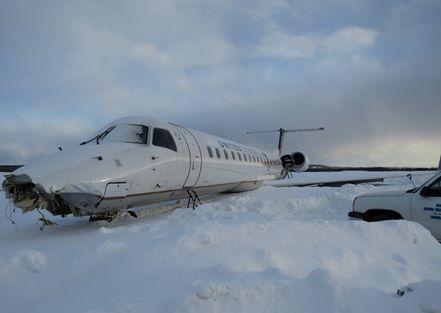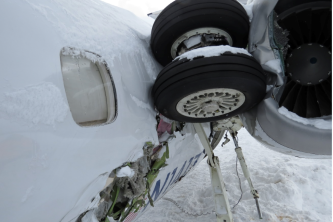
When it comes to flight and navigation instruments, there are few absolute certainties. Even though most instruments are fairly reliable, they are all susceptible to error.
Altimeters can be high or low, airspeed indicators inoperative, attitude and heading indicators can roll over or spin down. Pilots learn to look for the signs of these failures.
One of the instruments pilots have learned to trust is the instrument landing system (ILS).
If the frequency is tuned and identified, there are no warning flags, and the flight director pitch and roll steering bars are centered, you can feel pretty confident that you are on centerline and on glidepath, in a position to land right in the center of the runway.
A regional jet crew attempting to land in Presque Isle, Maine, found out that even the trusty old ILS can sometimes lead you astray.
On March 4, 2019, CommutAir Flight 4933, an Embraer EMB-145XR, struck the snow-covered infield to the right of Runway 1 at Presque Isle Airport (KPQI) while attempting to land.
On that wintry day, the visibility for landing was at the very minimum allowable for that approach, 0.5 mile, and there was moderate snow and freezing fog. The airport was also uncontrolled, so there was no tower to issue last-minute information or to coordinate airport snow-clearing activities.
The flight crew followed their localizer indication perfectly and wound up in the grass, 305 ft. to the right of the runway centerline.
An entire chain of safety barriers had to fail for the accident to happen. Before the crew made their last mistake, many other people had dropped the ball. The story shows how even minor oversights by people in safety supporting roles can be significant.
The flight originated in Newark, New Jersey, a major hub for CommutAir’s major partner, United Airlines. There were two pilots, one flight attendant and 28 passengers aboard, and the estimated time en route was 1:39.
At 1003 EST, the flight took off, and shortly thereafter climbed to FL350. At 1049, the pilots commenced a descent and began to prepare for the approach. The weather was concerning. The 1056 automated METAR was wind, 080 at 6 kt.; 0.5-sm visibility; snow; freezing fog; 1300 overcast; temperature, -2; dew point, -4; altimeter, 29.70.
At 1055, Boston Center read them the KPQI FICON (field condition) NOTAM for Runway 1. “You have a field condition of three, three, three, one hundred percent, quarter inch dry snow, and ah, yup that should be it. There is also a quarter inch dry snow on ah all of the taxiways as well braking action reported as medium, and ah half inch of dry snow on the apron.”
At 1059, the first officer (FO) briefed the ILS approach to Runway 1, saying ”There are no lights just the MALSRs down there, expecting what about a half mile and eleven hundred feet down there it shouldn’t be that bad if we do have a missed approach it’ll be a TOGA check max thrust flaps nine positive rate gear up, ahm we’ll do it with the box ah let’s climb to a hundred ah eleven hundred left turn to three thousand direct to PQI VOR and hold.”
The two pilots agreed to make a second approach if they missed on the first one. (Runway 1 was equipped with high-intensity runway lights.)
At the FO’s command, the captain read the descent and approach checklists, and the FO replied that they were complete. The captain tuned and identified the KPQI ILS, then selected the NAV approach button. Boston Center cleared them for the approach and at 1103, the captain called “Go green now—zero zero six,” then “forty-one thirty-one.”
After prompting, the FO called for flaps nine and said the “LOC’s captured.”
At 1105, Boston Center said, “CommutAir forty-nine thirty-three radar services terminated, change to advisory frequency approved, cancel on the ground one two one point six or with me in the air ah twenty-four seventy-five.”
The captain canceled IFR and switched to the KPQI CTAF. When the airport’s maintenance manager replied, she told him she was 4 min. out. The runway was clear.
The glideslope came alive, the crew extended the landing gear and flaps to 20, set speed bugs and set the altitude alerter for the missed approach altitude of 3,000 ft. They then went to flaps 45, completed the landing checklist and the captain called out passing the final approach fix. She said, “Thousand to go, stable,” and “ground contact.”
When the captain clicked the mike switch five times, the FO reminded her the airport lights frequency was 122.6, and she then repeated the five clicks.
The captain made callouts at 500, 400 and 300 ft., and the FO then said, “Autopilot comin’ off.” An electronic voice called “autopilot, autopilot,” then “approaching minimums.” Following her 100-ft. call, the captain said, “Runway in sight. See it?”
The FO replied, “Yeah—well I got somethin’ looks like a runway up there.”
Actually, there was nothing there. The crew had made a textbook approach up to this point, and then they made their first error. They were lined up, not with the runway, but with an AWOS antenna well to the right of the runway.
As the FO looked out, he allowed the nose to rise, prompting the captain to call out “Watch your speed yeah watch watch your, go, go up, go up, go up, go up, go up!” The stick shaker sounded. Again, she called, “Go, go missed, go missed.” “TOGA, check thrust flaps nine.” “Go, go, go,” she exclaimed.
The FO apologized for “looking at the wrong thing,” but when the “don’t sink” voice came on the captain said again, “Go up, go up, go up!”
The “landing gear” master warning sounded. The captain handled the warning, made the missed approach radio call, and got the gear and flaps up.
She got the airplane settled down and turned around and began preparing for a second approach.
The crew seemed baffled about what went wrong.
The FO asked, “What the heck happened?” The captain said, “I thought I had the runway then it was like that is not the runway!” After the captain’s brief reply, the FO then asked, “Did you ever see the lights at all last time?” Her reply was equivocal. “It’s really white down there—that’s the problem.”
The crew’s strategy for the second approach was essentially the same as for the first except for one thing. The FO planned to focus hard on the ILS flight director steering bars, even below 200 ft., and wait for the captain to positively identify the runway.
The captain said, “Just stay on the flight director and the glideslope and ah a lot of times what I’ll do is I’ll stay in there ’cause otherwise once you go out visually ah, you know, you start going high and low and then it gets really screwed up.”
The FO replied, “That’s just me being a rookie…. I just realized my error last time—I was overconfident. After I went visual, I quickly realized that was the wrong way to do business.” The captain said, “Yeah, stay inside and I’ll let you know when you can look up.”
This strategy, based on a misperception of what happened, was also contrary to company policy. The policy stated the pilot flying should monitor the instruments until the callout “runway in sight,” then transition to outside references no later than 100 ft.
Thirteen minutes after the missed approach, Boston Center again cleared CommutAir 4933 for the ILS to Runway 1. The FO immediately said, “Got the ground already this time.”
At 200 ft., the FO disconnected the autopilot at the captain’s direction. When the electronic voice announced, “minimums, minimums” the captain said, “Alright runway in sight twelve o’clock lights are ah.”
“OK I’m stayin’ on the flight director ‘cause I don’t see it yet.”
Ten seconds later the first sounds of the hard landing were recorded.

Again, the captain said, “What the ####” and the FO said, “I don’t know what I’m seein’.’’ The pilots still did not know what they had done.
Eleven seconds later, someone is recorded on the cockpit area microphone. “I got it, I got it, the localizer was ####.” Finally, the pilots understood what happened.
The crew ran the engine shutdown checklist and began to coordinate with the flight attendant to conduct an evacuation. According to the flight attendant, the landing was rough and violent. She had all the passengers remain seated until the L1 door was open.
Firefighters walked through deep snow to reach the airplane, then a snowplow cleared a path to the door.
A ladder was raised to allow the passengers to deplane. A firefighter helped the FO, who had a head wound, to exit first. Snow around the airplane was up to the bottom of the fuselage.
Besides the FO, two passengers sustained minor injuries.
In Part 2, we’ll discuss the NTSB’s investigation into this accident.






Comments